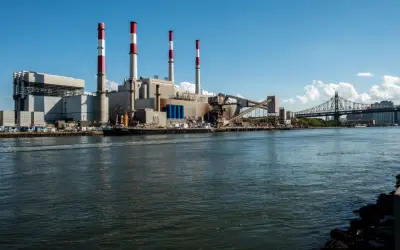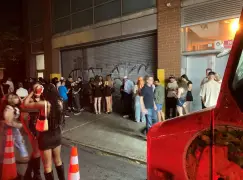Opinion: NYC’s Next Mayor Can Make a Clean Energy Grid a Reality

“Right now, New York City’s energy grid is working overtime to keep up with demand that is rising more quickly by the day because of electric devices, electric vehicles, and AI. That puts the city at real risk for more blackouts, like we saw in 2019, and that risk will only grow.” The Ravenswood Generating Station in Queens, which represents more than 20 percent of New York City’s generation capacity. (Photo by Adi Talwar) Next to skyrocketing rents and economic shockwaves created by the federal government, New York City’s mayoral candidates might not think clean energy is an urgent problem, or a problem they can fix. They’re wrong on both accounts. Right now, New York City’s energy grid is working overtime to keep up with demand that is rising more quickly by the day because of electric devices, electric vehicles, and AI. That puts the city at real risk for more blackouts, like we saw in 2019, and that risk will only grow. The most likely outcome is that Con Ed will be required to increase the use of so-called “peaker plants” this summer. This is bad news for New York City residents. Peaker plants use oil or natural gas to produce energy, spewing much higher rates of greenhouse gases into the air. Not surprisingly, they’re mostly located in the same low-income communities of color already dealing with higher rates of asthma or other problems because of energy production. They’re also expensive, at a time when New Yorkers are facing potential double-digit rate hikes for power costs. Other solutions, like the city’s mandated building retrofits or building new nuclear plants, could help solve the energy grid problem. But they’ll take decades to really get off the ground, assuming safety concerns about nuclear plants can be met. (function(d,u,ac){var s=d.createElement('script');s.type='text/javascript';s.src='https://a.omappapi.com/app/js/api.min.js';s.async=true;s.dataset.user=u;s.dataset.campaign=ac;d.getElementsByTagName('head')[0].appendChild(s);})(document,54625,'u4kmqsczew4vunxutxmd'); But believe it or not, there’s a straightforward solution to the energy grid problem that we can advance in a few years, not a few decades. And if we do it right, it will return much-needed dollars to the communities that have been most affected by the pollution caused by energy creation. We can build coalitions and communities of people who simply agree to use less energy. This is called “demand flexibility.” For example, if enough building owners and tenants agree to allow a utility to raise the temperature (via the internet) in their building a few degrees on a hot day or allow the utility to tap into their EV car or solar battery, this has the same effect as having an additional power plant to supply energy. Organizations that put together such agreements between building owners, community residents, and utilities are called Virtual Power Plants (VPPs). Here’s where the next mayor comes in. With a focused effort, New York City’s mayor could relieve significant pressure on the energy grid, save New Yorkers money, ease pollution in communities of color and light the way forward for more communities. New York City has many assets that could be assembled into VPPs. The New York City Housing Authority (NYCHA) has 177,000 apartment units, the Housing and Preservation Department has subsidized 150,000 apartments over the last 10 years alone, and 1,100 school buildings could be added, as well as CUNY campuses. As the city transitions to EV school buses, seldom used in the summer, their batteries could also feed the grid. Altogether, the city could organize a municipal VPP that would go a long way towards stabilizing the grid—at least for now. In addition, the city has an abundance of community and tenant organizations who are trusted in their communities that could do outreach to sign-up residents to join community-owned, or “CIVIC VPPs.” A little over five years ago, these same community organizations worked with the City to convince residents to fill out the Census, with great success. Civic VPPs could partner with local tech start-up companies emerging in the VPP space to connect resident households to the grid. Even if only a small portion of people joined right away, this Civic VPP effort could immediately relieve pressure on the grid, allowing closure of peaker plants, which create such serious health risks that the state has ordered them to shut down. Not only would that keep communities healthier, it will also save people a lot of money. Over the past 15 years, Con Ed has charged ratepayers around $5 billion to operate these peaker plants. Once VPPs are put in place, and peaker plants closed, some of the savings should be returned to VPPs that help maintain the grid. Some of the savings could also be used to beef up public school vocational education in needed green construction skills, helping to meet the city’s coming green workforce needs. It might also support civic education to help strengthen the underlying civic capacity that will be needed to broaden such efforts over time. A city-supported clean energy planning initiative could also enable larger, more effective, and more inclusive clean energy collaborations beyond VPPs. For example, Boston Medical Center (BMC), a safety net hospital, not only retrofitted its buildings for energy efficiency (lowering its energy bill), it also partnered with MIT to build a solar field in North Carolina. Revenue from the solar field is being used to subsidize utility bills for patients in Boston unable to afford air conditioning or heat. New York could create projects like BMC’s hundreds of times over, but only if there is leadership from City Hall. By providing leadership and support, City Hall could even help stem the effects of the Trump Administration’s move to strip $2 billion worth of EPA “Community Change grants” designed to support exactly this kind of organizing and work. A stable grid and clean air for the city’s future will depend on the next mayor. With the right leadership from City Hall, it can be reality, and sooner than we think. J. Phillip Thompson is a professor of urban planning at MIT and the former deputy mayor for strategic planning initiatives under the de Blasio administration. The post Opinion: NYC’s Next Mayor Can Make a Clean Energy Grid a Reality appeared first on City Limits.

